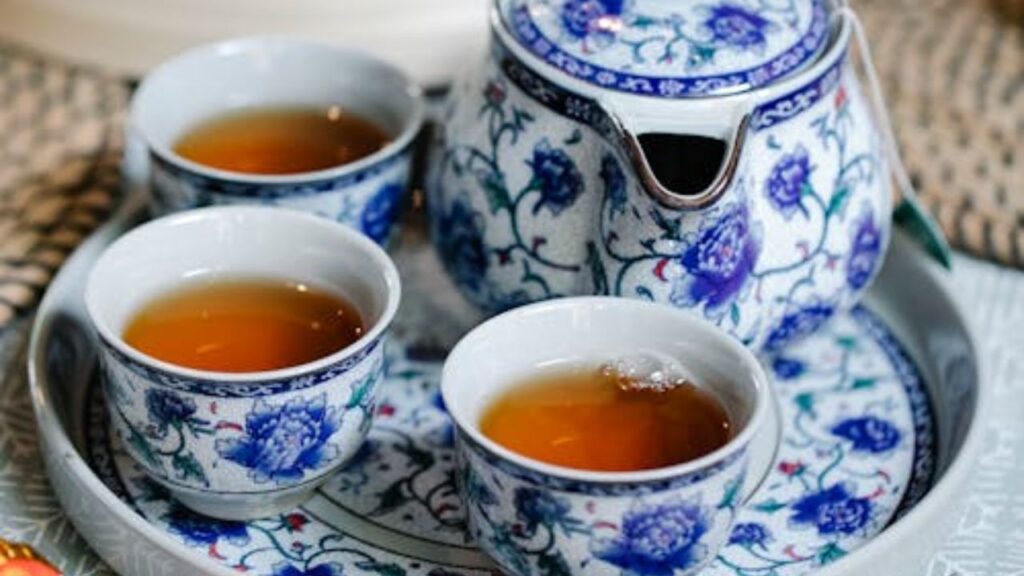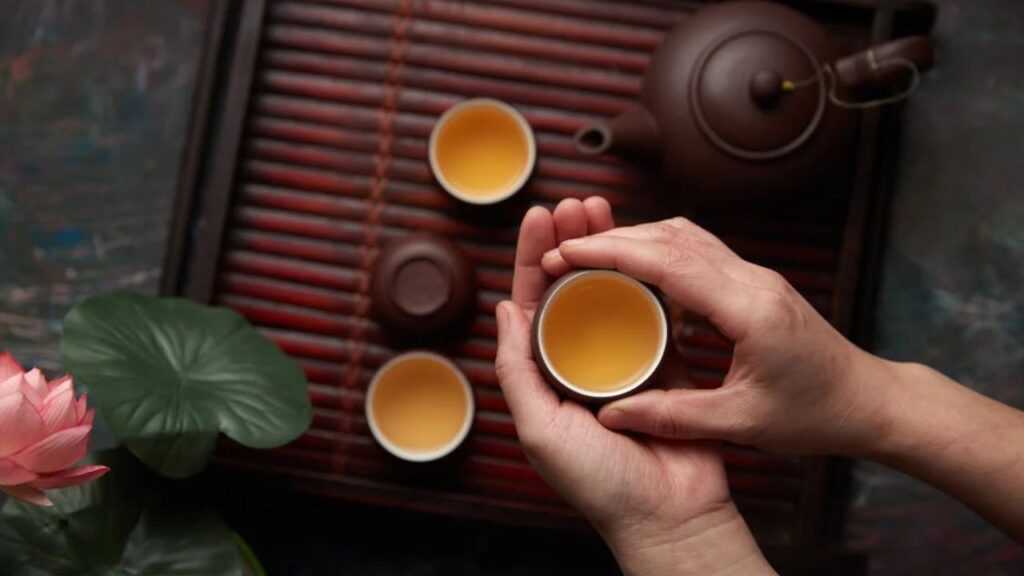A lot of Chinese restaurants offer patrons a range of teas complementing their delicious meals. Knowing these teas enhances the dining experience and gives understanding of Chinese tea practices and culture. While stressing the rich history and importance of tea in Chinese society, we will explore the several kinds of tea often available in Chinese restaurants, their advantages, and how they are customarily drunk in this article.

The Role of Tea in Chinese Culture
Originating in ancient kingdoms, tea has been a staple of Chinese civilization for thousands of years. It is a mark of welcome, respect, and custom as much as a drink. Many times, customers of a Chinese restaurant are welcomed with tea when they arrive. This custom captures the ingrained ideas on the value of tea for meals and social events. Serving tea shows the dedication of the restaurant to provide first-rate service and also reflects thankfulness and respect for the patrons. In Chinese culture, tea ceremonies are complex ceremonies with regional variations with individual customs and procedures. Emphasizing consciousness and respect for the materials, these rituals stress the beauty of tea preparation and affection.
Drinking tea is sometimes connected with community and connection when friends and relatives congregate around the table to exchange tales and enjoy their company. In Chinese restaurants, where it significantly improves the whole experience, tea is a necessary component of eating since of its cultural value.
Common Types of Tea Served in Chinese Restaurants
You will most surely find various kinds of tea on hand in a Chinese restaurant. Among the most consumed are green, oolong, black, and pu-erh teas. Every type tastes differently and offers health benefits fit for diverse events and cuisine. Popular for its fresh, grassy taste and several health benefits—including antioxidants improving general wellness—green tea Rich and elegant taste from oolong tea accentuates various foods and goes nicely with black and green coffee. Though black tea, generally more powerful and healthful, is praised for its taste, pu-erh tea, a fermented tea, has an unusual earthy taste and is noted for its digestive qualities. Knowing these teas and their features can allow you to appreciate meals more.
Green tea is light and invigorating, hence, when savoring delicate cuisine like steamed the fish or light vegetable stir-fries, you might be driven to select it. Likewise, oolong tea is very popular as it matches both sweet and savory meals. This variety not only fits a lot of palates but also helps one explore tastes and fragrances that would enhance the feast.
Green Tea: A Popular Choice
Maybe the most often used tea in Chinese restaurants is green tea, with its light, energizing taste that emphasizes diverse foods. Lighter cuisine would be ideal as its subdued taste accentuates the meal without overwhelming it. Strong antioxidant levels in green tea enable the body to resist oxidative stress, so health-conscious customers value it. Because of its properties of improving metabolism, green tea is also a beloved beverage for those aiming at a healthy lifestyle. Traditionally, a more real experience is made possible by making green tea from loose leaves rather than tea bags. Usually at less than black tea, its leaves are kept too steep in boiling water to retain its delicate nature.
Every taste reveals the special qualities of the tea, hence this particular preparation improves the whole experience. Many Chinese restaurants could provide green tea in small glasses so you could completely enjoy its taste and scent. Green tea enables one to relax and offers a moment of consciousness inside the busy scene of a restaurant.
Oolong Tea: The Perfect Balance
Oolong tea is semi-oxidized with a unique flavor and aroma that draws a lot of tea consumers among green and black tea.. Among those who value a more sophisticated flavor, its intricacy makes it a favorite. Processing technique and source will determine whether oolong tea is flowery, fruish, or creamy. This adaptability lets it go great with a range of cuisines, particularly rich or fatty items like roasted meats and dumplings where it may cut through the richness and improve the whole flavor experience. Making oolong tea is sometimes a sort of art in and of itself as several steepings let the tastes change. Different notes revealed by each infusion provide a dynamic and interesting taste sensation.
Many Chinese restaurants take great satisfaction in their oolong tea selections, sometimes highlighting premium leaves with a strong and delightful taste. Drinking oolong tea is about appreciating the workmanship behind the tea and savoring its sophisticated tastes as they develop with every drink, not only about satisfying thirst.

Black Tea: Bold and Robust
Often seen in Chinese restaurants, especially in line with heavier food, black tea is renowned for its austere taste. For individuals who prefer heavy food, its strong taste might rival the outstanding flavors of delicacies such sizzling stir-fries and grilled meats. Keemun together with Dianhong, the two kinds of Chinese black teas offer varied taste impressions since their flavor ranges from malty to smokey. Beyond taste, black tea is regarded for its health advantages—better heart function and more alertness brought on by its greater caffeine level than other teas. Black tea’s strong tannins balance a meal by helping digestion and maybe causing satiety. Many Chinese restaurants provide black tea brewed aggressively and hot so patrons may truly savor its strong taste. Usually seen with dim sum, black tea sharpens the range of tastes in the food.
Pu-erh Tea: An Earthly Delight
Tea is becoming very well-known as an unusual fermented tea with excellent earthy flavor and health benefits. Pu-erh is an excellent choice for those who consume a lot of rich foods since it is often consumed after meals and supposed to help in digesting and cleansing. Its complex taste varies with fermentation method and aging to provide unique flavor traits. A cool counterpoint to the powerful flavors and many Chinese cafes provide to help clean the palette after a large meal is pu-erh tea. Usually steeped multiple times, pu-erh tea requires different preparation than other teas. Every infusion enables the taste to grow, thereby offering a novel experience with every cup. Those who enjoy the depth and richness of pu-erh will particularly find this subtle taste experience fascinating.
Moreover, well-documented are the health benefits of this tea, which attracts those seeking to improve their overall state of health. Savouring pu-erh tea in a Chinese restaurant might be a great excursion with its rich flavors and scents, thereby enhancing the dining experience.
The Health Benefits of Chinese Tea
Chinese teas are valued not only for their numerous medicinal purposes but also for their tastes. Every kind of tea has special benefits that could help general health. Green tea’s antioxidant qualities, for example, could help fight oxidative stress and lower the incidence of chronic conditions. While black tea has been connected to improved heart health and more attention among those who value health in its potential to help with weight control and increase metabolic health, Pu-erh tea is praised for its digestive properties and capacity to decrease blood sugar levels. Starting to include these teas into your diet is one quick yet easy approach to improve your wellness. Many people who drink regular tea discover they feel more vibrant and refreshed.
Apart from that, the process and enjoying of tea might offer a moment of awareness inside a hectic day, therefore encouraging relaxation and release of tension. Choosing a tea to go with your supper when out not only improves the taste but also supports your general health.

How to Properly Enjoy Tea in Chinese Restaurants
One must know how to savor the tea presented at Chinese restaurants if one is to really value it. Usually presented in tiny glasses, tea lets you enjoy its scent and taste. Small sips are common practice and one may enjoy the subtleties of every kind of tea. Many eateries advise patrons to steep their tea several times as each infusion reveals unique flavors. Furthermore, combining tea with particular meals will improve the food and the drink, therefore producing a harmonic dining environment. Think of the food you are eating when you order tea. Green tea is a great option for smaller meals; oolong tea goes nicely with many cuisines.
Black tea is great with more substantial meals; pu-erh tea is best for rich, fatty foods. Investing time to investigate several tea selections will improve your eating experience and increase your respect for Chinese food. Moreover, talking with your waitress about the tea options might provide you insightful comments and suggestions, therefore enhancing the enjoyment of your dinner.
Difference Table
| Type of Tea | Flavor Profile | Health Benefits | Best Pairings | Preparation Method |
| Green Tea | Light, grassy | High in antioxidants, boosts metabolism | Steamed fish, light vegetables | Steeped at lower temperatures |
| Oolong Tea | Floral, fruity, creamy | Aids digestion, supports weight management | Dumplings, roasted meats | Multiple steepings for flavor |
| Black Tea | Bold, robust | Improves heart health, increases alertness | Spicy stir-fries, grilled meats | Brewed strong and served hot |
| Pu-erh Tea | Earthy, complex | Aids digestion, may lower cholesterol | Rich, fatty foods | Steeped multiple times |
Conclusion
Ultimately, the tea consumed in Chinese restaurants reflects culture, hospitality, and health more than just a beverage. Every variation, from the strong tastes of black tea to the reviving notes of green tea, presents a different taste and experience. Knowing how tea fits Chinese dining can help you to appreciate the food and the customs around it. When you go to a Chinese restaurant the next time, stop to appreciate the tea and everything it stands for. Accept the chance to investigate several kinds of tea, taste their tastes, and value the rich customs they reflect. Tea is an experience that ties you to the core of Chinese gastronomic tradition, not only a drink.
FAQ’s
1. What brand of tea do restaurants use?
Lipton black tea is often used in restaurants, especially for simple, unsweetened choices. Chain restaurants also include other well-known brands such Gold Peak and Pure Leaf. McDonald’s provides, for example, a combination of orange pekoe as well as pekoe cut black tea. Conversely, Chinese eateries usually feature Oolong tea to be a mainstay.
2. What tea is served at Yum Cha?
Yum cha really means “drink tea,” hence feel free to engage; the tea assists in cutting through oil and serves as a cleanser among bites. Alternatives include Longjing tea that is green, Tieguanyin tea with oolong leaves, flower tea (guk-fa), pu-erh black tea (bo lay). Every one of these kinds has a different taste that improves the dining experience.
3. What is the most popular Chinese tea?
From the West Lake area of Hangzhou, the province of Zhejiang, Long Jing, sometimes known as Dragon Well, is a remarkable imperial tribute tea. One of the most identifiable Chinese teas available globally, premium Long Jing has long, flat leaves in a vivid yellow-green color. Among tea drinkers, its unusual taste and scent make it a favorite.
4. What kind of tea is Chinese restaurant tea?
Chinese restaurants usually provide Oolong tea together with other types including Jasmine and blended teas, unless specifically asked by the client. Though less often drunk, pu-erh tea is also readily accessible.
5. What is the most premium Chinese tea?
But with an incredible worth of $1.2 million per kilogram, Da Huang Pao—not Pu-erh—owns the highest tea cost record.
